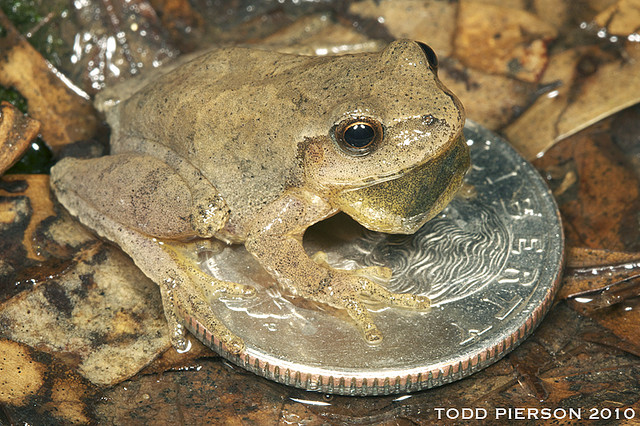Well, the quail she’s a pretty bird, she sings a sweet tongue,
‘neath the roots of tall timbers she nests with her young…
–“Black Waters” by Jean Ritchie
I live out in the country, on a dirt road. Though I’m used to the relatively common urban wildlife of Athens and Atlanta…including hawks, coyotes, and a blue heron I saw once during the Piedmont Arts Festival, which I mistook for art until it moved…rural southeast Georgia is something else again. The county I live in is pretty much 90% farmland, and is replete with ponds, rivers, streams, and woods. I have seen more wild animals parading across my yard in the last six months than I saw in six years of living in the hippietopia university town of Athens, which is no slouch in the green corridor department.
One twilight evening I saw a little covey of quail hurrying across the road. I mentioned it to my sister, who said, “That’s good to know. There are hardly any left.” I tried to remember the last time I heard the characteristic low then rising whistle of the bobwhite quail. It’s the only bird call I can mimic with any credibility, and I perfected it through long summer days as a child, trying to get the shy little birds to answer me. I realized I had not heard that song in years, maybe decades.
I noticed their absence before, but figured that the relatively urban areas where I lived just weren’t good bobwhite neighborhoods. The truth is nearly all of their habitat is gone. My sister, a hunter whose house is decorated in Early Duck Print and Winchester hunting dog rifle ads, already knew something I didn’t: The population of bobwhite quail has plummeted 84% in the last forty years, tracking neatly with a 99% decline in eastern grassland habitat.
Land use changes (read: population increase and urban sprawl) account for some of this…Atlanta is the Metropolis That Ate Half of Georgia…but the main culprit seems to be a radical change in farming practices. Leaving part of your farmland in wild thicket and fallow field is an ancient custom; in the British Isles this was called “the goodman’s croft,” an oblique reference to the fairy folk. If you did not leave a little room for wildness, the belief went, ill luck would follow. The belief and name mostly faded in the US, but the practice lived on. But we as a culture no longer truck with such ideas: “Modern, weed-free, fencerow-to-fencerow, high-intensity production leaves little habitat for most grassland birds…Cultivated cropland now is so free of weeds and idle areas as to no longer accommodate quail” says Don McKenzie, writing for the National Bobwhite Conservation Initiative‘s blog.
Ill luck follows. Not only bobwhite, but a variety of other species which share the same habitat have gone into steep decline…including rodent-eating predators and pollinating insects. For short-term gain, encouraged by U.S. government policy, agriculture is crippling its future and blighting livelihoods elsewhere; fishing, another big food industry in my home state as well as a significant source of tourist dollars, is directly harmed by the amount of toxic run-off that factory farms tend to produce. The human cost of the increasing toxicity of our food and water supplies is hard to quantify, but should not be discounted. Furthermore, there is mounting evidence that habitat destruction is followed by a host of unwelcome consequences…from increased vulnerability of coastal areas to flooding, to erosion, increases in wild animal attacks as they are forced out of their normal homes, and disease.
The change in agricultural practices represent a slow degradation. Sometimes habitat destruction is more direct, and the consequences more rapid. The song “Black Waters” by Jean Ritchie describes mountaintop removal:
http://www.youtube.com/watch?v=kFVdp1KJiqMThen the hillside explodes with the dynamite’s roar
The voice of the small bird will sound there no more
The mountain comes sliding so awful and grand
And the flooding black waters rise over my land.
I believe firmly that our fate and that of the small, unremarked creatures who inhabit our countryside are deeply intertwined…physically and spiritually. It’s one thing to talk about revering Nature as a kind of personified abstraction. But Nature is a real thing, a complex cohabiting web of real animals, plants, watersheds, microorganisms, habitats and yes, people with their various practices and cultures. We tend to think of our own culture as uniformly destructive and ascribe harmony with nature to other, more “primitive” societies…a form of “noble savage” stereotyping which does those other societies no favors and sells our own short, while simultaneously providing an excuse: technological society is inherently destructive, nobody is going to give up their cars and Internet, so what can you do? There is a falsehood embedded in this notion. All human societies are technological; a stone tool is technology, so is fire, and you can use both for slash-and-burn agriculture. Technology is morally neutral; what matters are the choices you make about how to use your technology, and the ethics underlying those choices. It wasn’t so long ago that we were doing better than this. I remember when hearing a bobwhite call was a common experience.
The other day I was in my back yard tending my garden, when I heard one: bob white? bob white? I was transfixed. I whistled back, badly; I am out of practice. But it replied, the rising note like a question I cannot answer: bob white?















